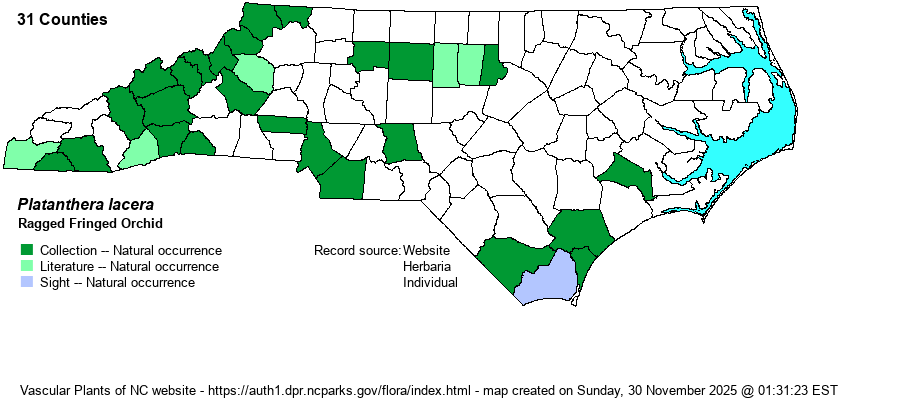| Author | (Michaux) G. Don | |
| Distribution | Scattered over nearly all of the Mountains. However, downstate it is found very sparsely in the Piedmont and southeastern Coastal Plain. Though it is found in many counties across southern VA from the coast to the Mountains, it is surprising that it has not yet been found in border counties of NC east of the Mountains, nor in the entirety of the state's northern Coastal Plain.
This is a very wide-ranging species in eastern North America, occurring from Newf. to Man. south to GA and northeastern TX, with only FL lacking records. However, it is quite local and scarce south of VA and MO. | |
| Abundance | Rare to uncommon, at least locally, in the Mountains. Very rare in the Piedmont and southeastern Coastal Plain, strongly declining in these regions, and certainly now extirpated from some of these counties. Mainly just in the Mountains now, with a few isolated extant downstate populations. | |
| Habitat | In the Mountains it is found mostly in bogs and wet meadows, in full sun. Downstate it occurs in a variety of wetlands, from seepages to swamps to savannas to damp sunny places, including marsh edges and ditches. Though it is not restricted to high quality sites, it is for some reason oddly scarce in the state considering its broad range farther north and its potential to occur in many damp habitats. |
| Phenology | Blooms from June to August, and fruits shortly after blooming. | |
| Identification | This is one of the more easily overlooked orchid species owing to its pale greenish or greenish-yellow flowers, typically matching the color of the stem and background vegetation. It grows about 1-1.5 feet tall, rarely to 2 feet tall. It has a typical Platanthera inflorescence of a dense raceme of several dozen flowers, with the flower cluster being about 3-4 inches long. Each flower is a bit less than 1 inch wide, but the three-parted lips are strongly dissected into many fringes. Thus, up close it is quite a striking plant, but at some distance it can be overlooked or not easily appreciated. There are no other similar looking species for confusion. | |
| Taxonomic Comments | None, other than previously being placed in the genus Habenaria -- i.e., Habenaria lacera.
| |
| Other Common Name(s) | Green Fringed Orchid, Ragged Orchid | |
| State Rank | S3 [S2S3] | |
| Global Rank | G5 | |
| State Status | | |
| US Status | | |
| USACE-agcp | FACW link |
| USACE-emp | FACW link |

